|
|
Post by bmoses on Oct 24, 2007 22:50:23 GMT -5
In mid-February, 1985, during archaeological monitoring of foundation excavations for the relocation of the Fairmont Hotel in La Villita, remains of what appeared to be a military entrenchment were uncovered. This project, located just southwest of the intersections of South Alamo and East Nueva Streets, proved to be the first archaeological evidence of the Mexican side of the battle of the Alamo. The endeavor began as an archaeological monitoring project by personnel from the Center for Archaeological Research, UTSA, as bulldozers bladed the new Fairmont Hotel property in preparation for the hotel’s basement.  Location of La Villita Earthworks in relation to the Alamo. Location of La Villita Earthworks in relation to the Alamo. 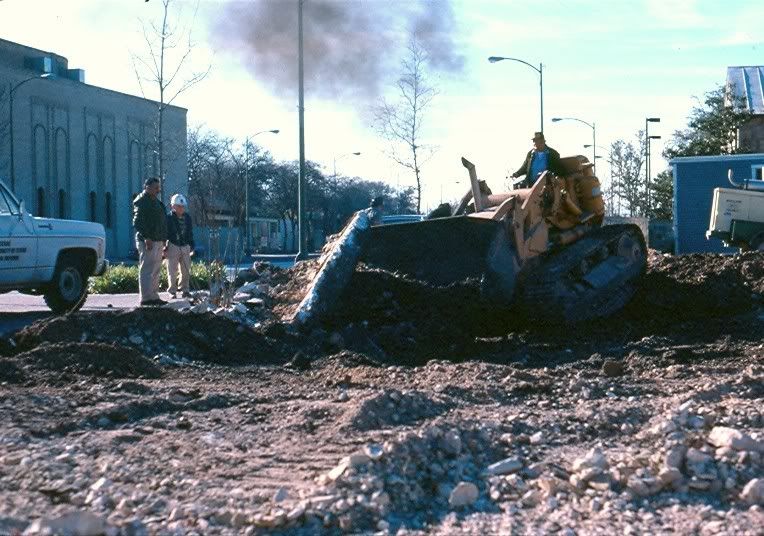 Initial dozing and archaeological monitoring underway at the site of the new Fairmont Hotel. Initial dozing and archaeological monitoring underway at the site of the new Fairmont Hotel.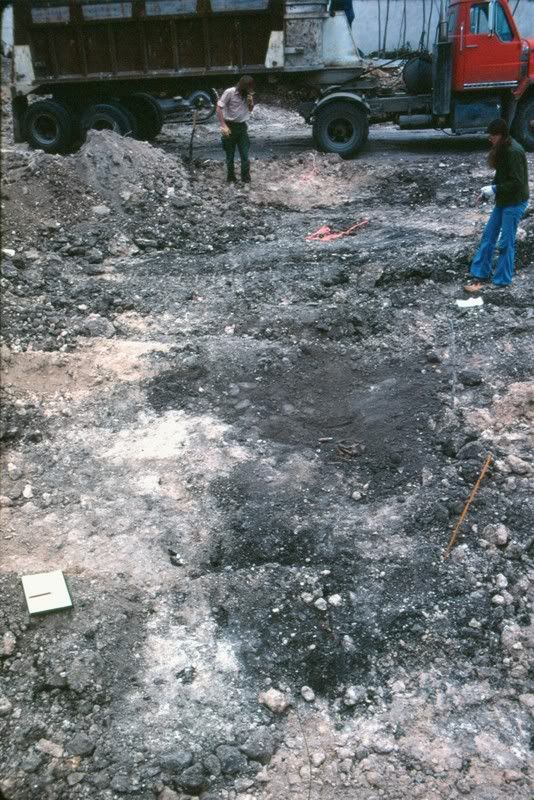 The dark ashy stain of the trench is initially inspected by UTSA archaeologists. The dark ashy stain of the trench is initially inspected by UTSA archaeologists.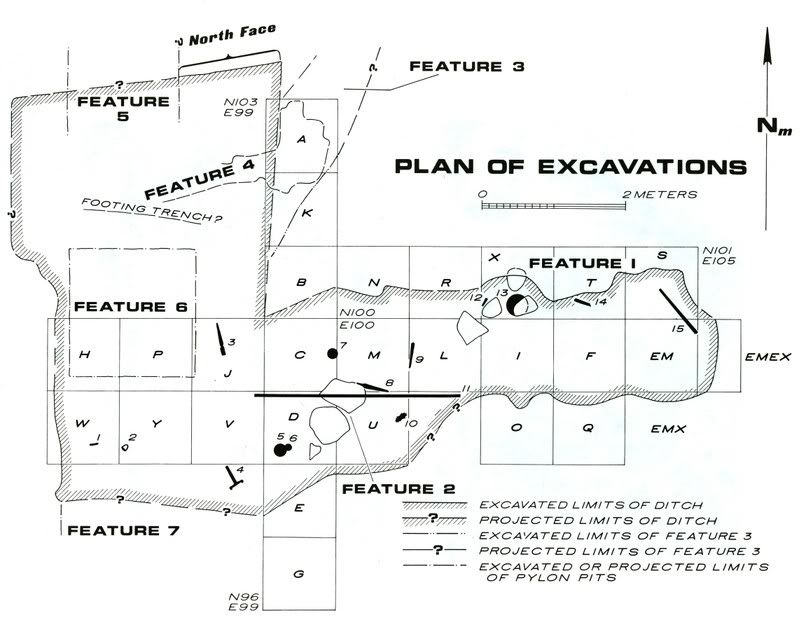 Plan of excavations. Hatched line shows approximate limits of the fortification ditch at the surface left after bulldozing.Mexican Earthworks Revealed Plan of excavations. Hatched line shows approximate limits of the fortification ditch at the surface left after bulldozing.Mexican Earthworks RevealedDuring the course of the work, a rather large dark stain was uncovered along with nineteenth century artifacts. Unfortunately, bulldozing had removed some of the fill before the trench was noticed and the elevation of the upper surface of the feature could not be determined. After a cursory investigation of the L-shaped stain, a series of shovel tests were placed in and around the feature to better determine the depth and vertical distribution of the deposits. Archaeologists then allowed dozing to continue in areas away from and surrounding the feature. As the rest of the soils were scraped away and hauled off out of the project area, archaeologists began to prepare the “island” (a nickname given to the remaining feature deposits because they stuck up almost 1.5 meters above other excavated portions of the site) for more thorough investigations. Full excavations began on February 20 and lasted a little more than a week. Fieldwork was supervised by Joe Labadie, Kenneth Brown and Dr. Thomas Hester, among others, and was greatly aided by the volunteer efforts of UTSA students as well as avocational archaeologists from the Southern Texas Archaeological Association. Suspicions were soon realized as it became clear to archaeologists that the L-shaped feature was, in fact, a hand-dug military entrenchment. The earth work was about 9.25 meters long east to west, with an eastern leg 1.3 to 2.75 meters wide. A shorter leg jutted out at the northwest end. However, the feature did not conform to expected nineteenth century European military design. The classic Continental design for an exposed battery position would typically resemble the point of an arrow with the tip facing the Alamo. Zones of Fill in the Trench Sediment fill inside the trench were of two general categories. The lowest zones consisted primarily of whitish-gray marl and mottled marl and caliche and had clearly settled back into the trench from the excavated materials and trench walls soon after the battle. The upper zone, referred to by archaeologists as “La Villita Fill”, consisted of thick ashy midden deposits which were dumped into the ditch in the months and years following the 1836 battle. This “La Villita Fill”, containing abundant animal bones, ash and midden debris, will not be discussed further in this summary. This lowest zone bore numerous nineteenth century artifacts including Spanish colonial ceramics, English ceramics, pressed glass, a glass crucifix, fasteners, horse gear (bits, stirrup, horseshoes), prehistoric artifacts and animal bones. There were also numerous artifacts clearly related to the time of the battle included two bayonets, one from a Brown Bess musket and another from either a French model 1777 or Baker rifle and modified into a pike. Other fragmentary or damaged weaponry included firearm accoutrements (gunflint pad blanks, gunflints, and balls), musket balls, a Baker rifle barrel, a Brown Bess trigger plate, frizzen, frizzen spring, and gunlock part, a Brown Bess (India pattern) musket buttplate, trigger-guard fragments from the Brown Bess musket and Baker rifle, a sword hilt, a lock plate and a hammer fragment for a pistol or small rifle, a pistol butt cap, and two Brown Bess ramrod pipes, grapeshot, canister shot, a solid iron shot for a nine-pounder field piece, and an unexploded 8 inch bronze howitzer shell fragment. However, possibly the most interesting feature recorded in the lower portions of this trench was a hearth located in a small alcove near the north face of the trench. The hearth consisted of three large limestone rocks arranged in a triangle with an ashy charcoal matrix. Embedded within the ashy soil was a badly rusted iron pot. Nearby, an iron knife blade was recovered and a large smooth flagstone was also observed. One other amazing find in these lowest sediments were paper fragments with writing executed in black ink with a quill pen. 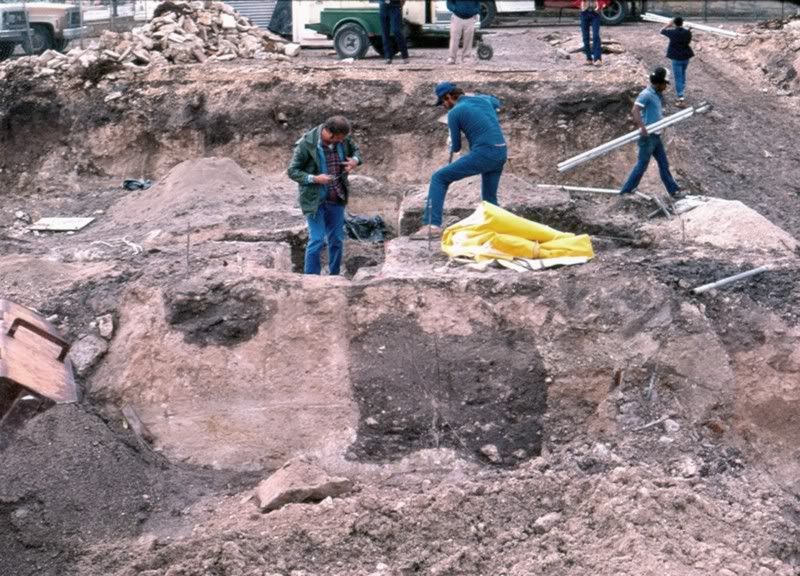 View looking south as crews begin setting up excavations on the "Island". The dark stain is the ashy Villita Fill of the trench. View looking south as crews begin setting up excavations on the "Island". The dark stain is the ashy Villita Fill of the trench. Profile of part of the north face of the Island, looking south. Profile of part of the north face of the Island, looking south.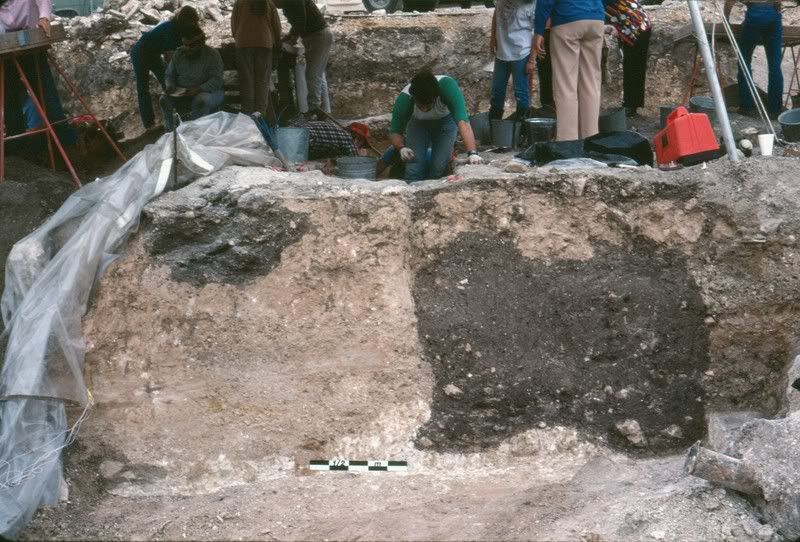 Excavations underway on the Island. Excavations underway on the Island.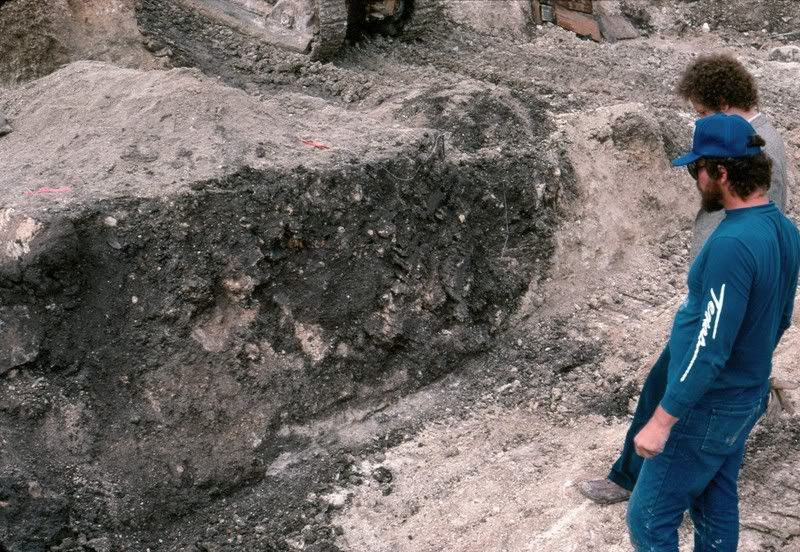 Archaeologists observe exposed portions of the earthworks while dozing continues in the background. Archaeologists observe exposed portions of the earthworks while dozing continues in the background.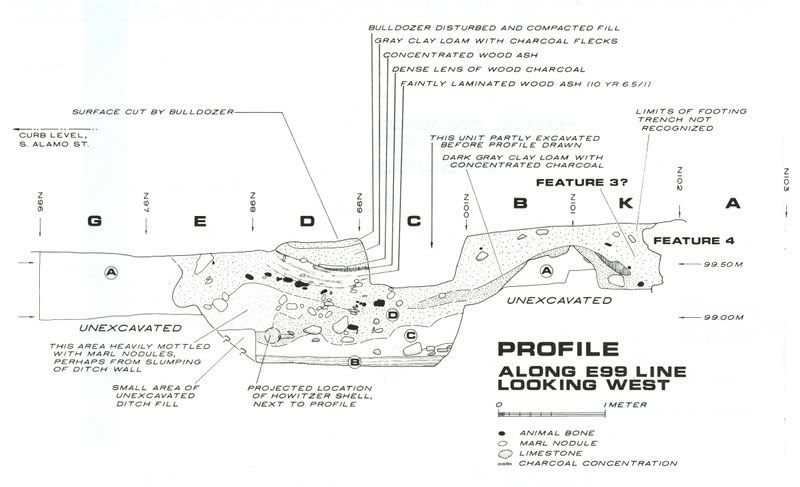 Profile of the Island wall looking west.Conclusions Profile of the Island wall looking west.ConclusionsTo the archaeological community, La Villita Earthworks affords the single best look at a site created and occupied during the Siege of the Alamo. However, the military function of the Villita Earthworks and its role in the battle is unclear since historical sources do not identify the earthworks. This feature is thought to have been excavated by soldiers of the Mexican Army in February, 1836, and the trench would have had a commanding view of both the Concepción and Goliad roads. Arguments that the fortifications were constructed during the earlier siege of Bexar fall short. There is no mention in historic accounts of entrenchments anywhere near the vicinity of La Villita during the first siege, only descriptions of breastworks in the vicinity of Main Plaza and west of the Alamo near Houston Street. Another curiosity is the fact that the trench does not conform to contemporary plans for infantry or artillery placements. This could be possibly be explained if the trench had been excavated near a home or other structure, or if the an assault on the position was not expected. It has been calculated that some sixty-five cubic meters of alluvial terrace fill had to be removed to form the ditch. From the remaining portion of the site’s surface, the trench was about 1.9 meters deep. In many ways the trench compares in width and depth to the ditches along the lunette and palisade on the south Alamo wall. Of the numerous projectiles recovered during the project including expended and unexpended Mexican ammunition, it is also possible that some of the rounds may in fact have been fired by the Alamo defenders. While howitzer shells can clearly be attributed to the Mexican army (they have been matched with shell fragments found at the Alamo), grapeshot, solid shot, and canister were used by both sides.  Local PBS channel KLRN-9 records a story on the archaeology at La Villita. Local PBS channel KLRN-9 records a story on the archaeology at La Villita.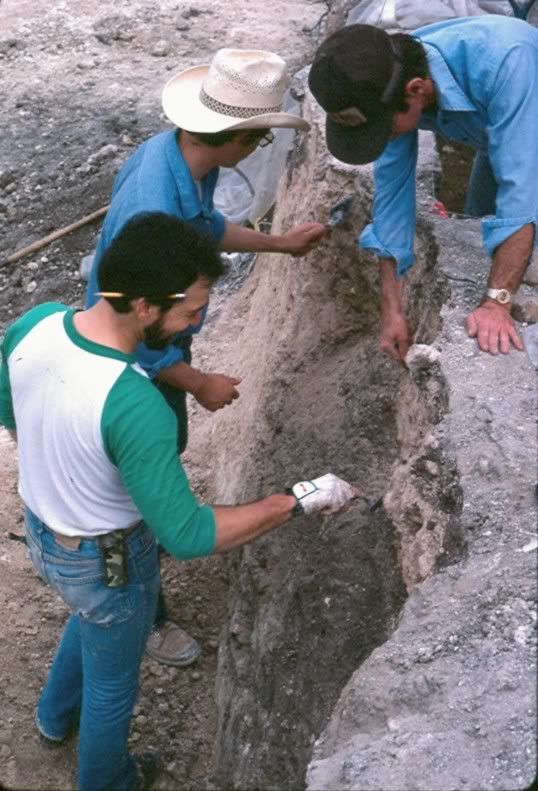 Cleaning the face of the Island in preparation for profile drawings. Cleaning the face of the Island in preparation for profile drawings.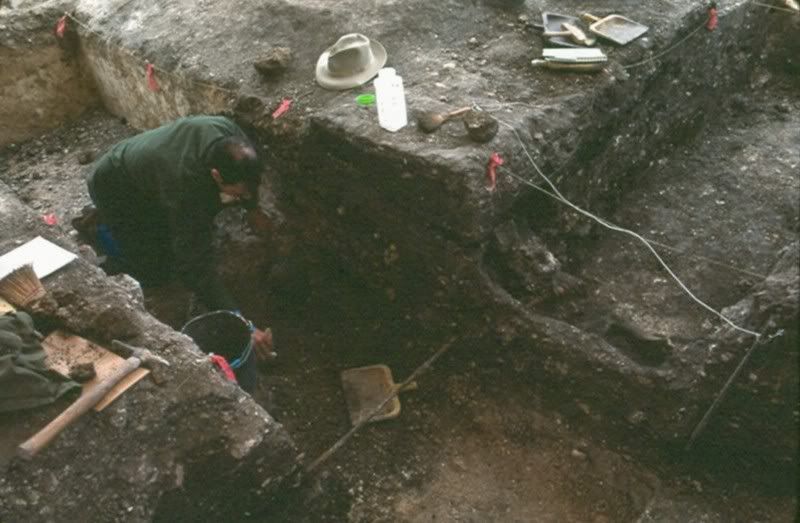 An archaeologist working in Unit D uncovers an unexploded 7-inch howitzer shell. An archaeologist working in Unit D uncovers an unexploded 7-inch howitzer shell. Brushing dirt away from the cannonball. Brushing dirt away from the cannonball.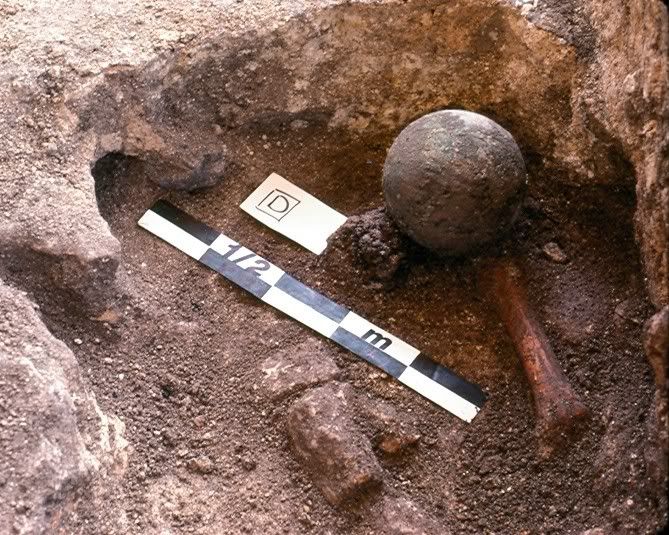 Howitzer shell resting above bovine bones. Howitzer shell resting above bovine bones.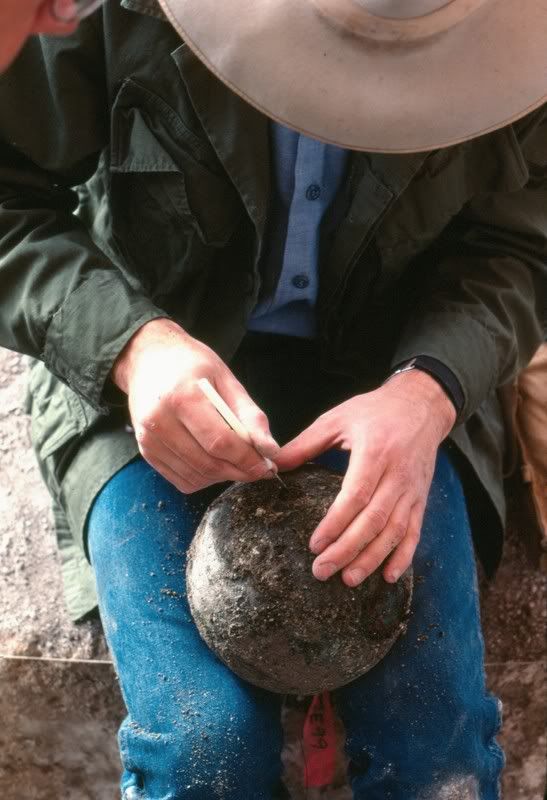 Cleaning the shell. Cleaning the shell.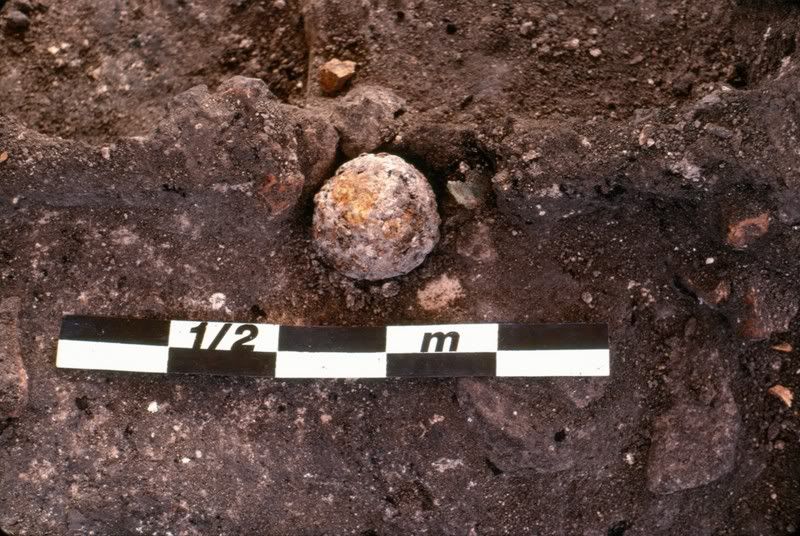 Iron solid shot cannonball for a nine pound cannon recovered from Unit D near the howitzer shell. Iron solid shot cannonball for a nine pound cannon recovered from Unit D near the howitzer shell.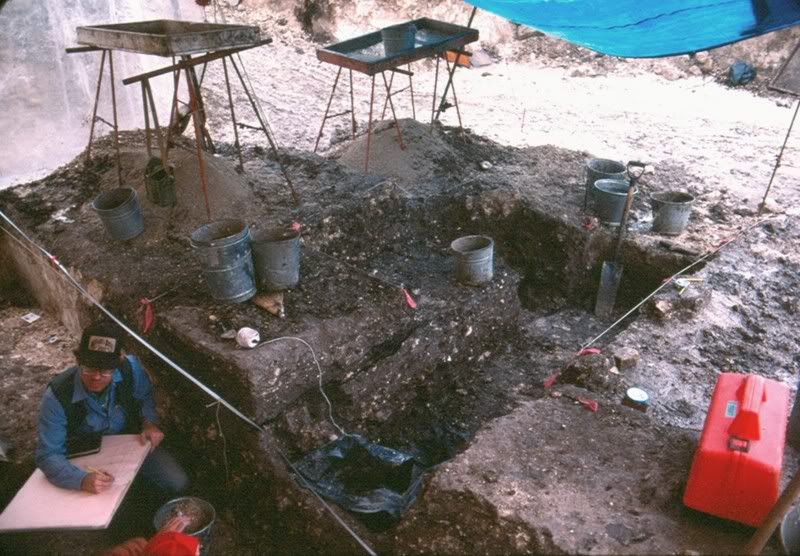 Overview of the excavations looking southwest. Overview of the excavations looking southwest.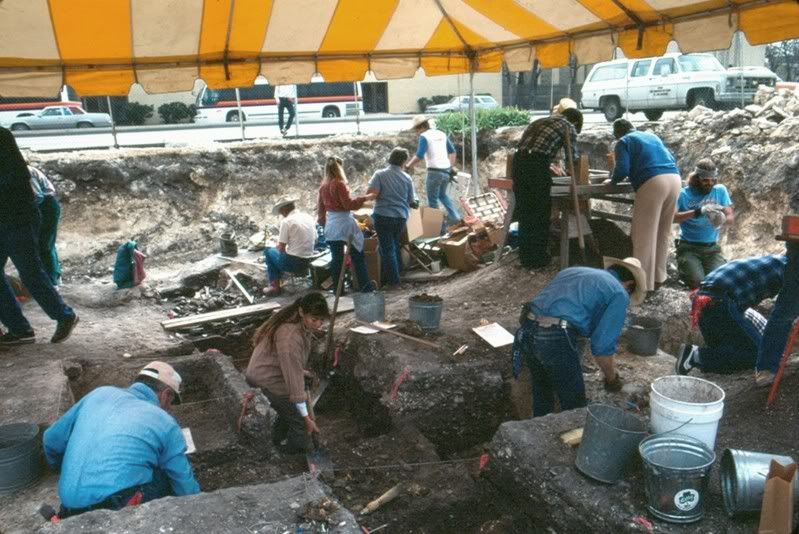 Overview of the excavations looking toward the east-southeast. Overview of the excavations looking toward the east-southeast. Gunflints recovered from La Villita Earthworks, site 41BX677. Gunflints recovered from La Villita Earthworks, site 41BX677.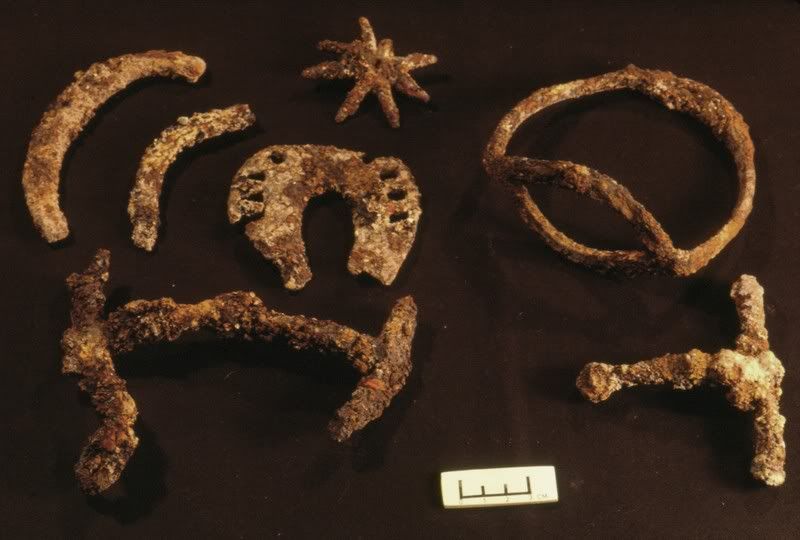 Horse equipment. Horse equipment.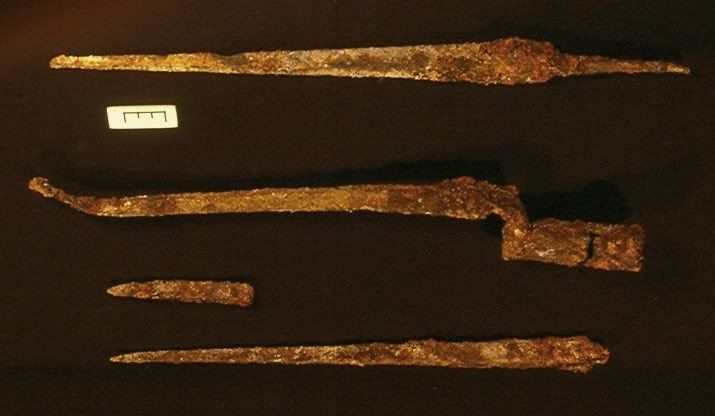 A badly oxidized tringular blade pike head (top), a badly oxidized tringular blade bayonet manufactured for a Brown Bess (center, missing the tip), and a badly oxidized tringular blade and shank portion from abayonet manufactured for a Brown Bess. A badly oxidized tringular blade pike head (top), a badly oxidized tringular blade bayonet manufactured for a Brown Bess (center, missing the tip), and a badly oxidized tringular blade and shank portion from abayonet manufactured for a Brown Bess.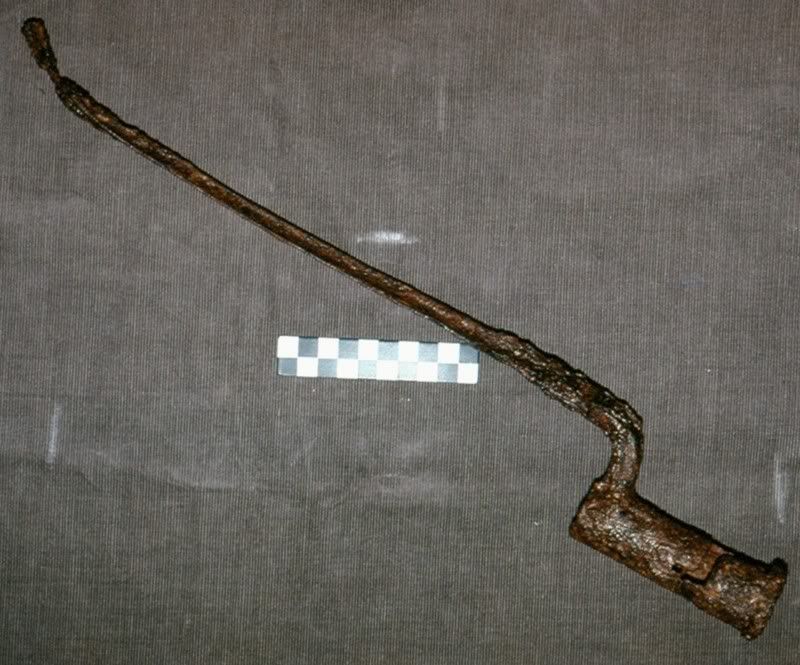 Brown Bess bayonet after stabilization proceedures. Brown Bess bayonet after stabilization proceedures.  Fragment and unfired bronze 7-inch howitzer shells. Fragment and unfired bronze 7-inch howitzer shells. |
|
|
|
Post by bmoses on Dec 9, 2007 15:47:05 GMT -5
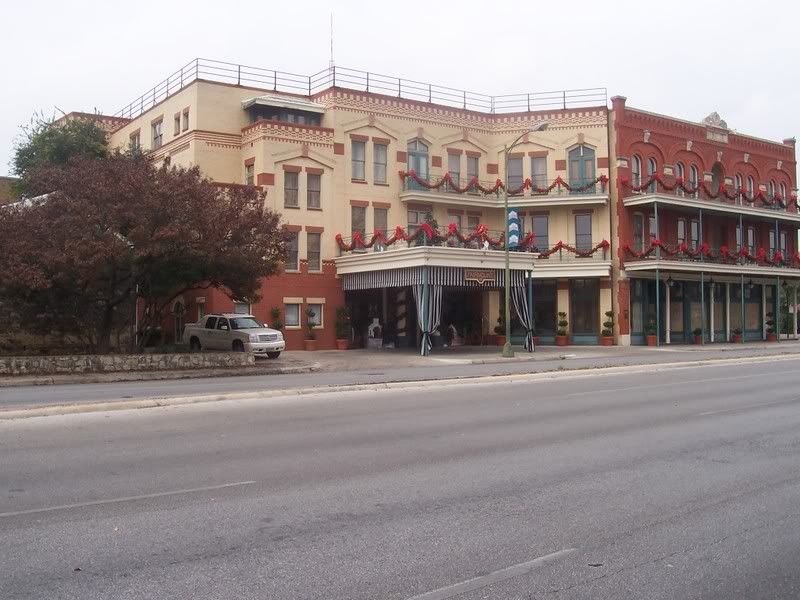 For anyone wishing to visit the site of the La Villita earthworks today, the position was located under the southern portion of the Fairmont Hotel which is painted tan in the photograph above. |
|
|
|
Post by trh on Jan 16, 2008 23:09:22 GMT -5
Bruce: the paper with ink (quill??) was intrusive -- might have even blown in during that
windy, rain, and cold event. We took it to the Harry Ransom Humanities Research Center at
UT Austin, where they do (did?) studies of paper, authenticity of documents. The notes should be in the CAR files, or hit up Labadie for them. The paper was essentially "modern" --
not the sort (rag content,etc.) of the 1830s. That's the nice thing about howitzer shells --
they don't blow around during an excavation with 50 people tramping around....
Tom
|
|
|
|
Post by bmoses on Jan 17, 2008 1:23:05 GMT -5
Bruce: the paper with ink (quill??) was intrusive . . . not the sort (rag content,etc.) of the 1830s. I thought that was a pretty amazing find under those conditions and was wondering why nothing more was ever reported on the paper. I also noticed that the report was considered an interim report - as though a more complete final report was planned for the project. I'm assuming that like so many archaeological projects, reality never lived up to the intentions (translation= the money dried up!). |
|
|
|
Post by Jake on Jan 25, 2008 12:12:06 GMT -5
Bruce: I posted this over on the Mexican Numbers thread, but I thought I'd put it in here, as well, where it belongs:
On Hansen p. 441 in the San Luis Potosi journal, under Feb. 25 is the remark that "During the night, construction was taken to protect the line that had been made at La Villita, at the orders of Colonel Morales." This sounds like a reference to the La Villita earthworks, and is another use of the word "line" to indicate defenses. It probably has some relationship to the defensive positions set up south of the Alamo on Feb 25 as described by Filisola, Hansen pp. 388-89.
|
|
|
|
Post by bmoses on Dec 24, 2008 12:51:19 GMT -5
I regret to bring to everyone's attention the most unfortunate loss of the howitzer shell pictured in the original post above. News came from the Fairmont Hotel yesterday that the artifact has been stolen from a display in the hotel's lobby. The Director at the Center for Archaeological Research had asked the Fairmont for the return of the artifacts several years ago (they are to be permanently curated at the Center) but that the directors at the Fairmont insisted on keeping the artifacts for display. Here is the full article from today's San Antonio Express-News as well as a link to the original: www.mysanantonio.com/news/Cannonball_linked_to_Alamo_siege_reported_swiped.html. Cannonball linked to Alamo siege reported swiped
By Robert Crowe - Express-News
A historic cannonball stolen over the weekend likely never saw action in 1836, but the hefty little artifact has remained relevant after 172 years with the help of the Fairmont Hotel.
The softball-sized cannonball — originally owned by Santa Anna's Mexican army during the Battle of the Alamo — was stolen between 9 p.m. Sunday and 3 a.m. Monday from the lobby of the hotel at 401 S. Alamo St., police said.
Investigators have no clues or suspects, but a police report indicates the crime appears to have been “skillfully done,” with the cannonball removed from a plastic display case. Some hotel employees have speculated that the cannonball may have been taken on a whim by an inebriated reveler during a party at the hotel's restaurant.
“I'm hoping it was just a prank, and someone will be nice enough to return it; no questions asked,” said the Fairmont's owner, Robert D. Tips. “It's a piece of history for San Antonio and for the hotel, and we'd just like to have it back.”
A reward is being offered, Tips said, but he's unsure of the amount.
“This is an incredible piece of Texas history that was stolen,” said archaeologist Joe Labadie, who helped discover the cannonball and other artifacts as a graduate student at the University of Texas at San Antonio.
Labadie and a team of archaeologists found the cannonball in the spring of 1985 as the hotel was preparing to move from Bowie and East Commerce to its current location. The 3.2 million-pound, three-story building was moved five blocks in March and April of 1985 to make room for a new retail development. It still holds the Guinness World Records title for the largest structure ever moved on wheels, Tips said.
Before the move, the corner of South Alamo and Nueva was a parking lot outside La Villita. A city ordinance required an archaeological study of the location before the hotel could be moved there.
“I was given a contract to watch a bulldozer tear up a parking lot,” said Labadie, who now lives in the Del Rio area. “No one expected us to find anything.”
While a huge moving rig pulled the hotel toward the site at a snail's pace, Labadie's team of archaeologists and students found a treasure trove of artifacts.
“That was the largest single discovery of artifacts associated with the Alamo,” he said. “It was especially significant because it told the story of the Mexican side of the war.”
The team discovered the cannonball and a larger, hollow cannonball, thought to be a howitzer round, along with dozens of musket balls and pieces of China dishes and cups in an L-shaped trench deep below the parking lot surface.
Labadie said the cannonball's location housed Santa Anna's cannon emplacement described by William Travis in his famous letter from the Alamo.
“I am besieged, by a thousand or more of the Mexicans under Santa Anna,” states the letter, dated Feb. 24, 1836, according to the Texas State Library and Archives Commission. “I have sustained a continual Bombardment and cannonade for 24 hours and have not lost a man.”
Hundreds of cannonballs, often called “wall bangers,” pummeled the Alamo's south walls, Labadie said. Because the Fairmont's cannonball was found hundreds of yards away from the Alamo, archaeologists suspect it fell into a muddy pit before it could be fired against the Alamo by the Mexican army.
The Fairmont's owners said tour groups often stop by the display of artifacts in the hotel lobby during tours of the city's historic sites. The artifacts are displayed under an agreement with UTSA, which has archived other items found in the original dig, Labadie said.
“I'm interested to know if UTSA was aware that the cannonball was still there,” Labadie said.
Officials with UTSA's anthropology department could not immediately be reached for comment. Tips, the hotel's fourth owner since 1985, said he was unaware the hotel, built in 1906, had a display agreement with UTSA.
“Whoever took the cannonball, please return it,” he said. |
|
|
|
Post by Jim Boylston on Dec 24, 2008 21:47:55 GMT -5
Sorry to hear about the theft, but it's good to see you back around, Bruce! Hope all is well.
Jim
|
|
|
|
Post by Paul Sylvain on Dec 25, 2008 18:05:34 GMT -5
Great security in that place, huh?
Interesting read and photos.
|
|
|
|
Post by bmoses on Jan 3, 2009 22:01:28 GMT -5
Well, it looks like some stories have happy endings after all! Two joggers found the artifact Tuesday at O.P. Schnabel Park on San Antonio’s north side. They say they saw a plastic garbage bag on the ground with a note pinned to it stating "valuable artifact." See the full story here: www.mysanantonio.com/news/Alamo_ammo_recovered_returned.html |
|
|
|
Post by Paul Sylvain on Jan 3, 2009 22:10:05 GMT -5
This is a happy ending, indeed. I hope the hotel does something to beef up its security so something like this doesn't happen again.
Paul
|
|
|
|
Post by bmoses on Jan 3, 2009 22:16:05 GMT -5
I hope the hotel does something to beef up its security so something like this doesn't happen again. Unfortunatly, I have a feeling that this artifact will soon be headed back to the curatorial facility. |
|
|
|
Post by mexicanjoe on Dec 9, 2009 16:41:08 GMT -5
Strategically overlooking perhaps the most heaviliy transited intersection of our state's camino real network, does anyone know if this is the same site of the Army Quartel where Juan Bautista de las Casas recruited his men before taking control of San Antonio in January of 1811 (Casas Revolt)?
|
|
|
|
Post by bmoses on Dec 14, 2009 12:21:05 GMT -5
The quartel did indeed house the enlisted men who joined Captain Juan Bautista de las Casas in January of 1811, and the barracks were located one block north and one block west of these entrenchments which were located just southeast of South Alamo Street and East Nueva Street. The 1836 Mexican artillery earthwork referred to as the “La Villita Earthworks” rests some 230 feet (70 meters) southwest of the old Spanish quartel which was in use between 1810 and 1815. The southeast corner of the timber constructed quartel was located a short distance north of East Nueva Street along King Phillip Alley. The square barracks extended west parallel to Nueva 83 varas (approximately 231 ft.) to South Presa Street and north the same distance to Hessler Street (parallel and just south of La Villita Street). The barracks were first proposed in 1805 as a part of Manuel Antonio Cordero’s plans to improve the regions military defensibility upon growing concerns over the deal between France and the United States over the vast Louisiana territory. Construction began in 1809 and was completed in 1810 for two new companies, the auxiliary militia of Reyno de Nuevo León and the auxiliary militia of the Colonia de Nuevo Santander. 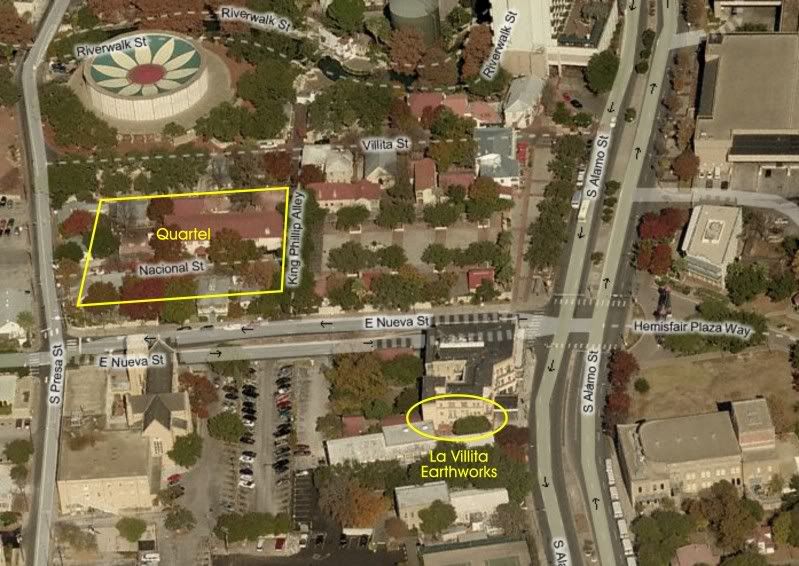 |
|
|
|
Post by sloanrodgers on Dec 15, 2009 21:16:54 GMT -5
Interesting research and photos Bruce. Judging from my minute experience, I know these excavations must be difficult. In the course of landscaping my yard I've unearthed all kinds of strange artifacts (ammonites, Tylostomas, etc) from bygone eras. The hardest are old tree stumps, but I hired a friend to dig them up on tearing my rotator cuff. A few months ago I bought an iron 9 pder. cannon ball from a guy who said it was dug up in San Antone. I may bury it my yard among the fossils and start a mystery for the next owner.  |
|
|
|
Post by bmoses on Dec 15, 2009 22:33:26 GMT -5
I may bury it my yard among the fossils and start a mystery for the next owner.  A good mystery sure makes for an interesting story - and as an archaeologist I've heard some doozies! The other day, a land owner called and described finding evidence of an early- to mid-nineteenth century homestead on his property. He insisted that it was actually the site of one of the early battles for San Antonio, even though it is miles from the general area where historians have placed the site. Now, over the years I've learned not to dismiss a lead out of hand, so I asked him to tell me more about any artifacts that may be associated with the battle. He informed me that while he hadn't personally found any military items, the former property owner had once found a large cannonball. I was excited about the prospect and told him I'd love to stop by and see it... ...and that is where the story went south. It seems that many years ago the former owner had dug that cannonball up from under a wonderfully old Live Oak tree. He had been so proud of finding that cannonball that when he died, his wife decided to bury it with him. So it goes. |
|




























